Nandina (Nandina domestica) is a beautiful landscape shrub with vividly colored leaves and crimson red berries that blooms throughout the year. Heavenly bamboo, Chinese holy bamboo, and holy bamboo are all popular names for Nandina bushes. The bright red or pink leaves of Nandina, a low-growing shrub, decorate the bush in the spring, fall, and winter.
The berries of nandina are poisonous to birds, despite the fact that it is popular in many residential gardens. It’s also invasive in many places, and it’s banned in others. You may, however, opt from a variety of nandina cultivars that don’t bloom and fruit, making them suitable for cultivation in gardens.
Growing heavenly bamboo in a front or backyard is the subject of this article. You’ll also learn how to keep the nandina decorative shrub healthy so that its vibrant leaves may be seen throughout spring, fall, and winter without concern.
Nandina (Nandina domestica) Facts

Nandina domestica (heavenly bamboo) is an ornamental garden shrub with crimson berries and summer green leaves that turn crimson in the fall. Nandina’s vibrant red berries and colorful leaves are two of its appealing features. Nandina bushes produce reddish-pink new leaves in the spring.
Greenness prevails through the summer, until the leaves turn crimson in color and berries reappear in fall and winter. Nandina thrives in full sun or partial shade and grows best in USDA zones 6 to 9. When temperatures drop below 10°F (-12°C), nandina bushes lose their leaves, and at 5°F (-15°C), stem damage occurs. The sturdy, hardy shrub, on the other hand, normally recovers.
Nandina domestica grows to be 6 to 8 feet (1.8 to 2.4 meters) tall and broad, with a lifespan of up to three years. Nandina grows at a pace of 12 to 24 inches (30 to 60 cm) each year. Nandina may be a high-maintenance shrub that needs regular pruning to keep it from spreading too much because of its suckering nature.
The fact that nandina bushes are adaptable to most conditions is one reason they are so popular in gardens. Nandina thrives in a variety of soil types, is drought tolerant, and is pest and disease resistant.
What Does Nandina Shrub Look Like?

Nandina bushes have cane-like stems and lanceolate leaves that resemble bamboo, and they grow upright. It has common names like Chinese sacred bamboo and heavenly bamboo because nandina bush is native to Asia and looks like bamboo. The upright nandina shrub is adorned with red leaves and brilliant red berries from fall to spring. The shrub’s leaves and berries range in color from green to yellow throughout the summer.
Types of Nandina
The genus Nandina contains just one species, Nandina domestica. Several nandina cultivars, on the other hand, deserve consideration. The nandina plant, which grows to be 7 feet (2 meters) tall and 5 feet (1.5 meters) broad, is a typical example. During the summer, its leaves are glossy green, but in the autumn and winter, they are tinted reddish-purple or dusty pink. In the autumn, bright scarlet berries appear and stay through the winter.
The following are some of the styles of heavenly bamboo plants:
Nandina ‘Gulf Stream’
The nandina ‘Gulf Stream’ In garden landscapes, heavenly bamboo of this type is the most common. Pinnate leaves, abundant red berries, and clusters of tiny white flowers characterize the ornamental evergreen shrub. In the fall, the nandina ‘Gulf Stream’ foliage turns green, then crimson, before changing to a bronze-orange color.

Nandina domestica ‘Gulf Stream,’ a smaller variant of nandina shrubs, grows between 3 and 4 feet (1.2 to 1.5 meters) tall and broad. As a low informal hedge, shrub borders, container gardens, foundation planting, or specimen plant, the sun-loving shrub thrives in landscapes.
Nandina ‘Sienna Sunrise’
Nandina ‘Sienna Sunrise’ In the spring and autumn, it has vivid red leaves on a tiny decorative shrub. Nandina ‘Sienna Sunrise’ is a 4-foot (1.2-meter) tall and 2-foot (0.6-meter) broad plant. Compact gardens or containers are ideal for this nandina shrub. Because birds don’t eat it, it’s safe to have in your garden since it doesn’t produce berries.

Nandina domestica ‘Lemon Lime’
Nandina domestica ‘Lemon Lime’ In the spring and fall, the leaves of this dwarf nandina plant are vivid green. This plant grows up to 4 feet (1.2 meters) tall and does not flower or produce berries.
Heavenly Bamboo ‘Moyers Red’
Heavenly Bamboo ‘Moyers Red’ Nandina is a 6-foot (1.8-meter) tall and 5-foot (1.5-meter) wide semi-dwarf landscape shrub. The pink blooms of this nandina bush are intermingled with crimson red berries. In the fall, the green foliage become dark red.
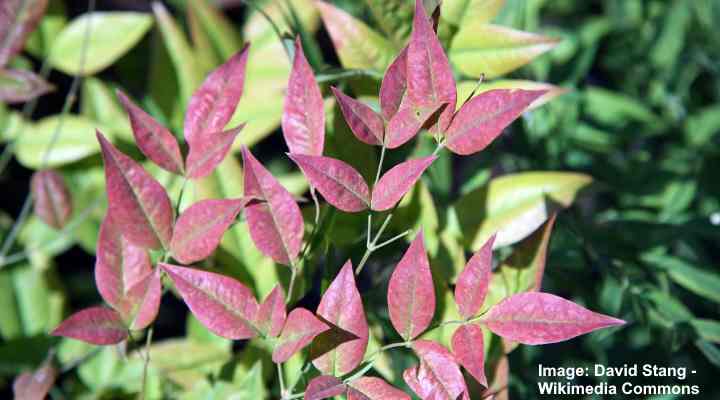
Nandina ‘Flirt’
Nandina ‘Flirt’ In full sun, it’s a low-growing mound-like plant that can be used as ground cover. In the spring and summer, the exceptional leafy foliage is dark purple-red, while in the winter it brightens red.
Nandina domestica ‘Fire Power’
Nandina domestica ‘Fire Power’ with glossy lanceolate leaves, it is a tiny evergreen shrub. In the summer, yellowy-green leaves turn warm red and orange hues, while in the autumn, small mounding nandina shrubs display yellowy-green leaves. The Nandina bush, dubbed the ‘Fire Power Bush,’ does not bloom or produce berries. It can grow to be up to 1.6 feet (0.5 meters) tall and broad.

Nandina domestica var. leucocarpa
Nandina domestica var. leucocarpa The nandina plant, a tall non-invasive shrub with white fruit and lovely light green leaves, is a popular ornamental. The appearance of real bamboo is closely mimicked by this nandina shrub.
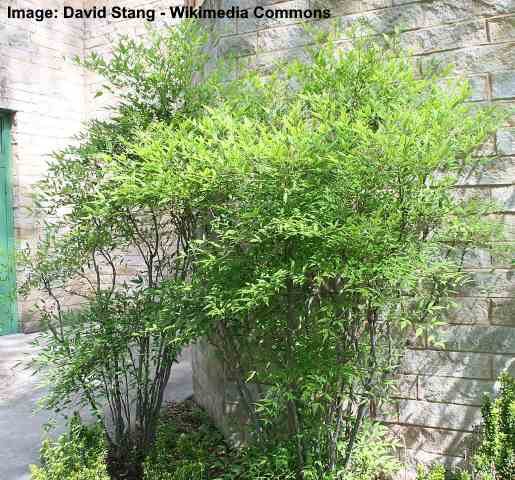
Nandina domestica ‘Otafukunanten’
Nandina domestica ‘Otafukunanten’ The nandina shrub is a tiny plant that only grows to 2 feet (0.6 meters). This is a popular landscaping shrub because of its circular, mounding development, lovely pinkish-red glossy leaves, and absence of berries.
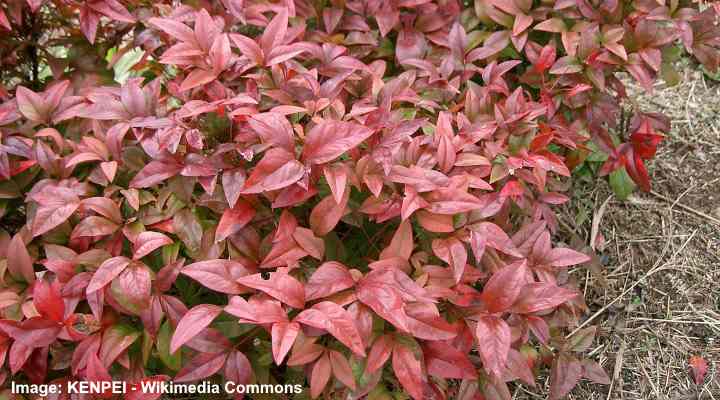
Nandina ‘Plum Passion’
Nandina ‘Plum Passion’In the spring, fall, and winter, a nandina shrub with crimson-purple leaves decorates upright stems. The shrub’s little white blooms fade into brilliant red berries clusters. Nandina plum Passion grows up to 5 feet (1.5 meters) tall and broad, with 4 to 6 feet (1.2 to 1.8 meters) of stem.

Nandina domestica nana ‘Firehouse’
Nandina domestica nana ‘Firehouse’ Compact mound growth and brilliant green leaves characterize this dwarf nandina plant, which becomes crimson in the fall and winter. It grows to be about 2 feet (0.6 meters) tall and broad. Nandina ‘nana’ has no flowers or berries.

Nandina Bush Berries

Although most nandina plants produce clusters of vividly colored red berries hanging in loose bunches like grapes, they are toxic to birds. In the autumn, the crimson berries bloom and last all winter, giving nandina bushes year-round beauty. Berries may virtually cover the bright green leaves, giving them a cloudy appearance.
Nandina Domestica Flowers

Nandina blossoms bloom in May and June, and most of the nandina bushes produce little white or pinkish blooms. The little flowers, which grow in clusters of up to 12″ (30 cm) long, are up to 0.5″ (1.2 cm) wide. The bushes are grouped together and bloom better in full sun.
Nandina Domestica Leaves
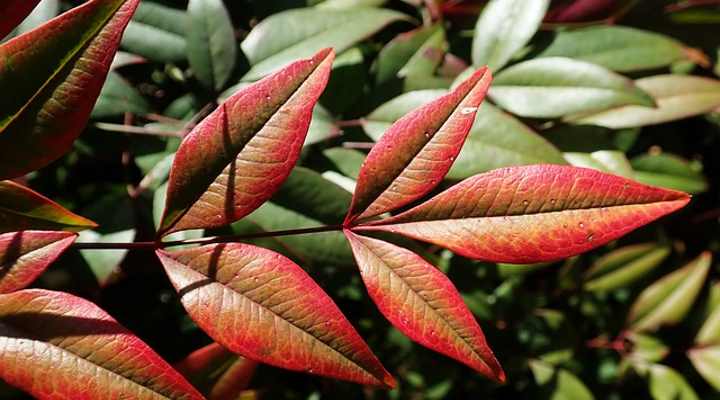
The pinnate leaves on nandina bushes are made up of multiple lance-shaped leaflets, and they are compound. The compound leaves may grow between 12″ and 24″ (30 – 60 cm) long, and each leaflet is 1″ to 3″ (2.5 – 7 cm) long. In the autumn, the evergreen nandina leaves turn red, green, and finally dark red, purple, or bronze.
Nandina Shrubs in Garden Landscapes
Heavenly bamboo adds a lot of decorative value to a garden landscape because of its colorful leaves. The shrub’s stunning leaf design and vibrant year-round colors, as well as its rich clusters of crimson berries, make it appealing for adding aesthetic appeal to an area.
Nandina plants may be used as an informal hedge, shrub border, or grouped with evergreen plants. To maximize the effect, plant it in clusters or mass plantings to produce a lot of blooms and berries. You may plant clusters of nandina bushes with different colored foliage to add to your garden’s beauty.
Nandina, for example, is a good choice as a landscaping plant for the Gulf Stream. Its ever-changing hues, white blooms, and crimson berries provide a lot of variety to an area. Nandina ‘Lemon Lime’ has chartreuse foliage, which you could choose.
Nandina Care
In a garden landscape, a nandina shrub is easy to care for. Nandina is a drought-tolerant plant that grows well in most soil types and can be pruned to remove suckers that shoot up. Full sun is ideal for the shrub-like bush, but partial shade is also acceptable. Let’s take a closer look at how to grow this colorful decorative shrub in your garden landscape.
Where to Grow Nandina Bushes
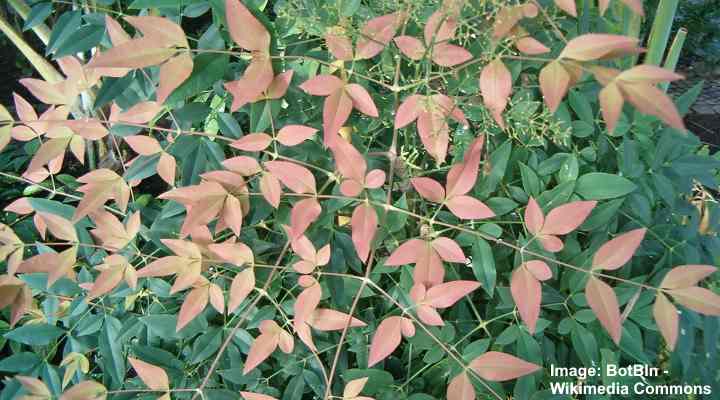
Nandina domestica plants prefers full sun and will grow best in that environment. Several Nandina cultivars, such as the Gulf Stream, can handle some shade. The bamboo-like canes may wither away with little foliage if there is too much shade during flowering.
Nandina thrives in the afternoon shade of zones 9 and 10. Your bamboo-like shrub will develop rich foliage if you plant it in full sun with some afternoon shade. During the winter, evergreen nandina bushes retain their leaves. Leaves acquire red hues thanks to the cold weather and strong sunlight.
How to Grow Nandina Shrub
To enjoy year-round color, Nandina domestica cultivars are often easy to grow in garden settings. Planting a nandina tree in rich, wet soil that drains well would be ideal. Nonetheless, most soil types and even poor ones are suitable for robust nandina plants.
It’s a wise strategy to keep the soil moist but not soggy for ideal development. When rainfall is scarce and the weather is hot and dry, this is particularly true. Nandina’s vivid leaves, flowers, and berries thrive in damp weather, even when it does not.
Watering the ground frequently enough to keep the root area moist is the best way to ensure healthy growth. Give the shrub a thorough watering by saturating the ground with water once the top layer of soil is completely dry. You should water nandina less often during the winter, when growth is dormant. If there hasn’t been any rain for seven days, the water heavenly bamboo is usually harvested. Otherwise, regular rainfall should suffice to keep the earth damp. Mulch around the root base may also help retain soil moisture.
When the leaves of a nandina bush start to wilt or turn pale, it’s a sign that it needs watering. To encourage the shrub to thrive, give it a thorough soaking before planting.
How to Fertilize Nandina
In the spring, Nandina bushes benefit from a fertilizer application. To help improve poor soil, apply a balanced, slow-release fertilizer. Fertilize with a fertilizer that is appropriate for rhododendrons or evergreens. To avoid root burn, thoroughly wet the ground after applying the fertilizer. If the soil is rich, though, nandina plants don’t need fertilizer to grow.
When and How to Prune Nandina Shrub
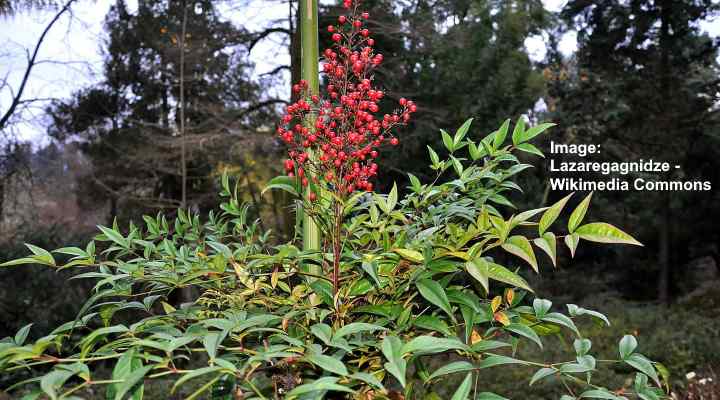
At any time of year, you may prune nandina domestica shrubs to regulate its growth. Nandina plants may be trimmed any time of year. To keep the shrub’s appearance natural, use sharp hand pruners to cut back old canes to the ground and trim other stalks at different heights.
You may prune stalks to one-third of their length every year for three years if a nandina shrub’s growth has gotten out of hand. This method of pruning helps revitalize neglected “sacred bamboo” plants. Compact nandina cultivars are another option for reducing garden labor. ‘Flirt,’ ‘Obsession Nandina,’ and ‘Blush Pink are three landscaping nandinas that don’t need pruning.
Transplanting Nandina
Transplanting nandina from pots or digging up existing plants to relocate to another area of your yard is simple. The fleshy roots of Nandina bushes make it simple to transplant them again. In the fall or winter, when the weather is relatively cool, is the best time to plant a nandina in the ground.
Dig a hole big enough for the root ball when transferring nandina from containers to the ground. Fill in the remaining space with fertile soil and water well before ensuring that the plant grows at the same height as before. To help keep the ground moist, put a layer of mulch over the soil.
Propagating Nandina
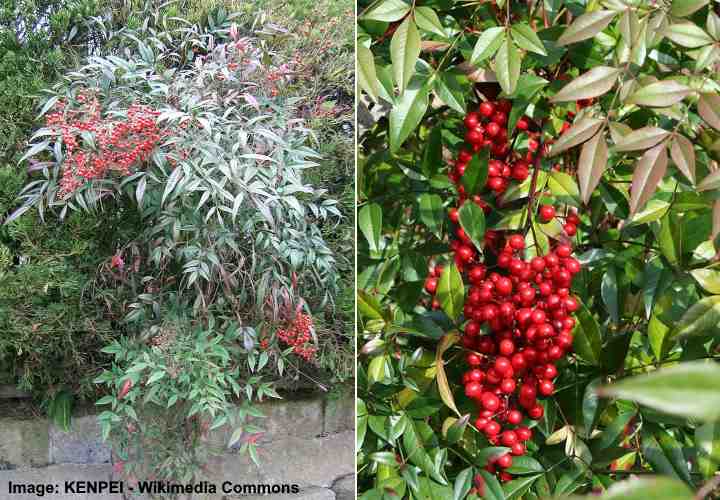
Softwood cuttings or dividing mature plants are both options for growing nandina shrubs. In early summer, all you have to do is chop a 6-inch (15 cm) section of tender stalk. Place the cutting in a pot of peat moss if any leaves are growing on the bottom section. To raise humidity, lightly water the soil and seal the plant in a plastic bag. Wait until the roots have developed before watering.
You can transfer the rooted cuttings to your garden or a bigger container after a few weeks. dividing established nandina plants that send out suckers is another way to propagate the plant. You can dig the suckers out of the mother plant and put them in your garden after they have a root system.
Pests Affecting Nandina Growth
Pests aren’t very bothersome to Nandina bushes. Mealybugs and whiteflies, on the other hand, may harm the plant’s development. Under the leaves, mealybugs appear as white, fuzzy cotton-like growths. You may detect whiteflies flying if you shake the branches since they lurk beneath the leaves.
These bugs may make leaves yellow and drop if they are not treated. It’s preferable to use a powerful stream of water to dislodge bugs from garden shrubs like nandina. Nandina also resists modest pest infestations by making sure that growing circumstances are ideal.
Diseases Affecting Nandina Growth
Disease seldom affects nandina bushes in ideal circumstances. Moisture concerns with waterlogged soil or insufficient air circulation may impact plant health, however. Resolving watering and humidity issues usually prevents additional damage.
Leaves or stems that show signs of disease should be removed and destroyed. Powdery mildew, for example, is a white powdery substance that forms on leaves when there is too much humidity and insufficient air circulation. It makes the plant look unattractive, despite the fact that it is not detrimental to its growth.
It’s important to water the shrub properly to avoid additional fungal or bacterial illnesses. Only when the top layer is dry should you water the ground. Nandina domestica withstands drought better than overly wet soil, as do many subtropical shrubs.
Is Nandina Toxic?

Cats, dogs, and birds are all poisonous to humans and animals. Cyanogenic glycosides are found in heavenly bamboo, according to the ASPCA. Berries or leaves may induce vomiting, convulsions, and respiratory failure in animals that eat them. If pets or children play in the garden, it’s a good idea to avoid planting nandina shrubs.
The crimson berries on this decorative shrub, according to doctors, may induce gastrointestinal discomfort when consumed. Nandina berries may cause vomiting, abdominal discomfort, diarrhea, and nausea as side effects.
Issues with Nandina Shrubs
The invasive nature of nandina shrubs is the most common problem. The berries of Nandina readily disseminate the seeds because to its extensive spread via suckers. Native plants are crowded out by Nandina bushes, which form dense thickets. Yet, non-invasive nandina types like ‘Firepower’ and nandina ‘Obsession’ are available to you.
The poisonous berries might pose a health risk to you if you have pets or children. A non-flowering cultivar that doesn’t produce berries might be selected in this instance.
